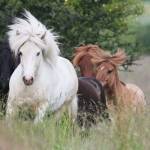Feeding Horses for Energy Without Obesity

A nutrition advisor at Kentucky Equine Research (KER) received a query from the owner of two ponies engaged in a little-known sport. The ponies are used as a pair in pulling competitions, just like those contested by much heavier drafters. The crux of the inquiry involved dietary energy. Read on:
“My family participates in pulling contests. Though we have a couple of Belgian teams, by far the most difficult team to nutritionally manage includes the two ponies—both of which are about 12 hands and way, way overweight, as in a body condition score (BCS) of 8. We know they should get a diet of limited hay and a handful of grain, but to be honest, that doesn’t provide enough calories for them to pull during the competition season, so we end up feeding more plain oats than we probably should to boost energy. Can you help me with a diet that provides sufficient energy for the quick bursts of energy needed to pull but not so much to cause spongy fat and a chance of foundering. Too much to ask?”
This owner has asked an age-old question: how do you supply ponies with sufficient dietary energy to work without overconditioning?
In the search for a sensible diet for these pint-sized pullers, forage should remain the foundation. Though an approximate body weight is not given, let’s assume the ponies should weigh about 400 lb (180 kg). Based on the common recommendation that equines of all sizes receive 1-2% of their body weight each day in forage and feed, these ponies should be fed 4-8 lb (1.8-3.6 kg) of forage and feed daily. Chances are, the ponies described above are getting much more than this if their current BCS is an 8.
As alluded to in the query, the ideal diet for these ponies would likely be 6-8 lb (2.7-3.6 kg) of mid-quality forage and a suitable vitamin and mineral supplement to top-off nutrients not provided adequately in the forage, as well as free-choice access to salt. Many ponies are revered for their sensible, phlegmatic view of the world and their level-headed reactions, so an abundance of energy is not required. For these ponies, especially those used as children’s mounts, such a diet would satisfactorily maintain body condition and power whatever work asked of them.
The aforementioned diet, however, probably does not adequately fuel the bursts of power necessary for easy pulls or the stamina for a long day of consecutive physical challenges.
The owner of the ponies realized this and added oats to the diet. Rich in starch, oats brought a bit of zing to their energy level and allowed them to be more competitive. The downside, however, has been an increase in body condition, which in the long term can contribute to joint problems, exercise intolerance, and early-onset metabolic disease.
In the off-season, when the ponies are not asked to compete, the following steps would help get them back into reasonable body condition.
Make diet changes little by little. Like their larger cousins, ponies don’t take kindly to crash diets, so all changes to rations should be made slowly. Ponies are at particular risk for hyperlipidemia when energy is pulled quickly from their diets, and hyperlipidemia can cause health problems.
Remove high-energy feedstuffs from ration. Take away the oats from the ration gradually, over the period of a week or two, and steadily add an appropriate vitamin and mineral supplement. Choose a supplement that is pelleted so it is easy to feed.
Borrow or purchase a scale for use in the barn. Weigh out 7-8 lb (3.2-3.6 kg) of mid-quality hay so you have a clear vision of what that amount looks and feels like. For example, is it three or four flakes of light, fluffy hay or two or three flakes of more densely packed hay?
Use grazing muzzles. If hay is not fed in the off-season and the ponies are instead pastured, use grazing muzzles to cut down on forage intake. Even with muzzles, ponies will have to be corralled in a drylot or stall for a portion of the day, where they can have access to mid-quality hay. One study indicated that grazing muzzles can reduce pasture intake by 80%.
Continue daily or near-daily exercise. Appropriate exercise comes in many forms, including longeing, long-lining, pleasure driving, or hand-walking. Regular structured exercise that increases heart rate—just 30 minutes a day—keeps metabolic issues from gaining traction.
Cut out treats. All snacks have calories, and the one thing overweight ponies don’t need are additional calories. The occasional cookie is not a problem, but feeding lots of treats every day is not a good idea.
Keep track of weight loss and body condition. Take the time to learn and understand condition-scoring methods so a record can be kept of losses. In addition to hands-on scoring, a weigh-tape can be used to track changes in weight. Keep simple notes such as this: “I can just feel his ribs, and there seems to be less fat near the top of his tail. 500 lb, according to weigh tape.” Consistent record-keeping keeps second-guessing to a minimum and weight loss on target.
Once ponies are in more moderate body condition, it is easier to add oats to the diet for extra energy during the competition season without fear of weight gain and laminitis risk. Moderation is key, however. For ponies this size, even a small amount of oats a day (1-2 cups; 0.25-0.5 lb; 0.1=0.2 kg) can increase energy levels sufficiently. Feeding the oats for a few days prior to the competition is also an option. Remember, adding or removing oats from the diet based on workload is perfectly acceptable, so long as diet changes are made thoughtfully and with the best interest of the ponies in mind.








